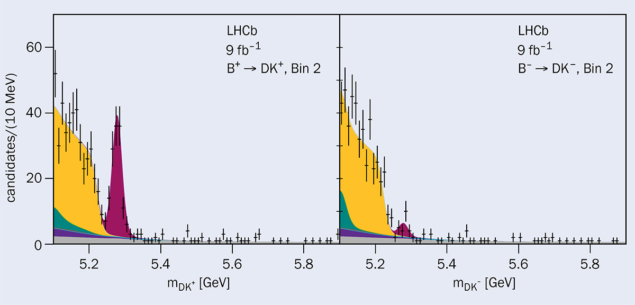A report from the LHCb experiment.

The Cabibbo–Kobayashi–Maskawa (CKM) matrix describes the couplings between the quarks and the weak charged current, and contains within it a phase γ that changes sign under consideration of antiquarks rather than quarks. In the Standard Model (SM), this phase is the only known difference in the interactions of matter and anti-matter, a consequence of the breaking of charge-parity (CP) symmetry. While the differences within the SM are known to be far too small to explain the matter-dominated universe, it is still of paramount importance to precisely determine this phase to provide a benchmark against which any contribution from new physics can be compared.
A new measurement recently presented by the LHCb collaboration uses a novel method to determine γ using decays of the type B± → D[K∓π±π±π∓]h± (h = π, K). CP violation in such decays is a consequence of the interference between two tree-level processes with a weak phase that differs by γ, and thus provide a theoretically clean probe of the SM. The new aspect of this measurement compared to those performed previously lies in the partitioning of the five-dimensional phase space of the D-decay into a series of independent regions, or bins. In these bins, the asymmetries between B+ and B– meson decay rates can receive large enhancements from the hadronic interactions in the D-meson decay. The enhancement for one of such bins can be seen in figure 1, which shows the invariant mass spectrum of the B+ and B– meson candidates, where the correctly reconstructed decays peak at around 5.3 GeV. The observed asymmetry in this region is around 85%, which is the largest difference in the behaviour of matter and antimatter ever measured. Observables from the different bins are combined with information on the hadronic interactions in the D-meson decay from charm-threshold experiments to obtain γ = 55 ± 9°, which is compatible with previous determinations and is the second most precise single measurement.
The matter–antimatter asymmetry reaches 85% in a certain region, the largest ever observed
The LHCb average value of γ is then determined by combining this analysis with the measurements in many other B and D decays, where in all cases the SM contribution is expected to be dominant. Measurements of charm decays are also included to better constrain both the parameters of charm mixing, which also play an important role in the measurements of B-meson decays at the current level of precision and help to constrain the hadronic interactions in some of the D decays. In particular, included for the first time in this combination is a measurement of yCP, which is proportional to the difference in lifetimes of the two neutral charm mesons, and was determined using two-body decays of the D meson using the entire LHCb data set collected so far.
The overall impact of these additional analyses reduces the uncertainty on γ by more than 10%, corresponding to adding around a year of data taking across all decay modes.
The improvements in the knowledge of yCP is also dramatic, reducing the uncertainty by around 40%. While the value of γ is found to be compatible with determinations that would be more susceptible to new physics, the precision of the comparison is starting to approach the level of a few degrees, at which discrepancies may start to be observable.
Given that the current uncertainties on many of the key input analyses to the combination are predominately statistical in nature, measurements of these fundamental flavour-physics parameters with the upgraded LHCb detector, and beyond, are an intriguing prospect for new-physics searches.
Further reading
LHCb Collab. 2022 LHCb-PAPER-2022-017.
LHCb Collab. 2022 LHCb-CONF-2022-002.
LHCb Collab. 2022 LHCb-PAPER-2021-041.







